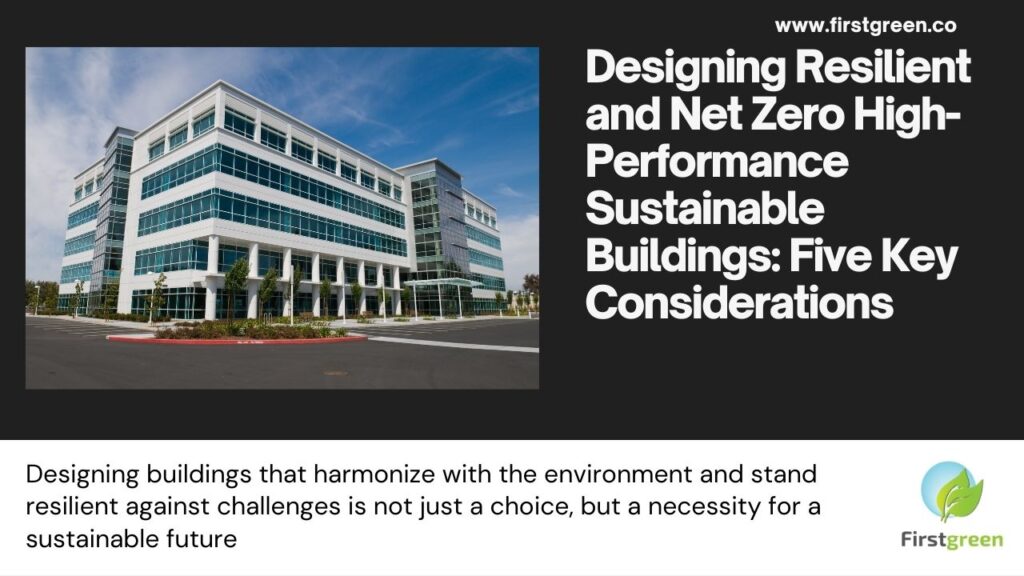Designing Resilient and Net Zero High-Performance Sustainable Buildings: Five Key Considerations

In today’s rapidly evolving world, the concept of designing resilient and net zero high-performance sustainable buildings has become crucial. These buildings not only contribute to reducing environmental impact but also ensure long-term sustainability and resilience against unforeseen challenges. Here are five key considerations to keep in mind when designing such buildings:
1. Energy Efficiency and Renewable Energy Integration
Achieving net zero energy requires a two-fold approach: enhancing energy efficiency and integrating renewable energy sources. Key steps include:
- Optimizing Building Envelope: Use high-performance insulation, energy-efficient windows, and advanced materials to minimize heat loss and gain.
- Implementing Efficient HVAC Systems: Utilize energy-efficient heating, ventilation, and air conditioning (HVAC) systems, including heat pumps and advanced controls.
- Incorporating Renewable Energy: Install solar panels, wind turbines, or other renewable energy systems to generate on-site clean energy.
2. Water Conservation and Management
Effective water management is essential for sustainable building design. Strategies include:
- Water-Efficient Fixtures: Install low-flow faucets, toilets, and showerheads to reduce water consumption.
- Rainwater Harvesting: Collect and use rainwater for non-potable applications like irrigation and flushing toilets.
- Greywater Recycling: Reuse greywater from sinks, showers, and laundry for landscape irrigation and toilet flushing.
3. Material Selection and Embodied Carbon Reduction
Selecting sustainable materials with low embodied carbon is critical for reducing the overall environmental impact of a building:
- Use of Recycled and Renewable Materials: Opt for materials that are recycled, renewable, or have a low environmental footprint.
- Local Sourcing: Source materials locally to reduce transportation emissions and support local economies.
- Lifecycle Assessment: Conduct lifecycle assessments to evaluate the environmental impact of materials from extraction to disposal.
4. Resilience to Climate Change and Natural Disasters
Building resilience involves designing structures that can withstand and recover from adverse events, ensuring minimal disruption and rapid recovery:
- Robust Structural Design: Ensure buildings are designed to withstand natural disasters such as earthquakes, hurricanes, and floods.
- Passive Design Strategies: Incorporate passive design elements like natural ventilation, daylighting, and thermal mass to maintain comfort without relying on active systems.
- Backup Power Systems: Install renewable energy storage systems, such as batteries, to provide backup power during outages.
5. Occupant Health and Wellbeing
Ensuring the health and wellbeing of occupants is a crucial aspect of sustainable building design:
- Indoor Air Quality: Use non-toxic, low-emission materials and ensure proper ventilation to maintain healthy indoor air quality.
- Natural Light and Views: Maximize access to natural light and provide views of nature to enhance occupant wellbeing and productivity.
- Comfort and Flexibility: Design spaces that are adaptable to changing needs and provide thermal, visual, and acoustic comfort.
Sample Checklist for Designing Resilient and Net Zero Buildings
| Consideration | Action | Benefit |
|---|---|---|
| Energy Efficiency | High-performance insulation, efficient HVAC | Reduced energy consumption, lower costs |
| Renewable Energy | Solar panels, wind turbines | Clean, renewable energy generation |
| Water Conservation | Low-flow fixtures, rainwater harvesting | Reduced water consumption, sustainability |
| Material Selection | Recycled materials, local sourcing | Lower embodied carbon, support local economy |
| Climate Resilience | Robust structural design, passive strategies | Enhanced durability, lower operational costs |
| Indoor Air Quality | Non-toxic materials, proper ventilation | Improved health and wellbeing |
| Natural Light | Maximize daylight, provide nature views | Enhanced productivity, reduced energy use |
| Backup Power Systems | Renewable energy storage systems | Reliable power supply during outages |
Conclusion
Designing resilient and net zero high-performance sustainable buildings is essential for addressing the challenges of climate change and ensuring long-term sustainability. By focusing on energy efficiency, water conservation, material selection, resilience, and occupant wellbeing, we can create buildings that not only reduce environmental impact but also provide safe, healthy, and adaptable spaces for occupants.
For more information on sustainable building design and how to achieve net zero and resilient buildings, visit Firstgreen Consulting. Our expertise in carbon credit services and energy efficiency can help you navigate the complexities of sustainable building design.


